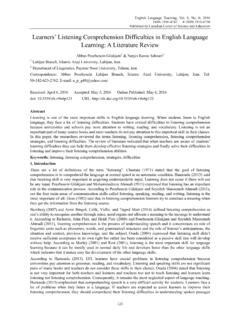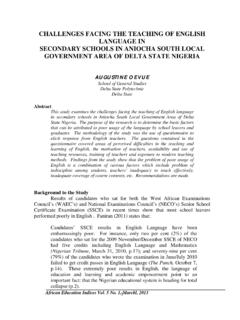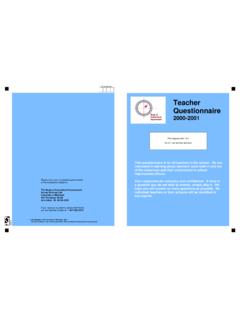Transcription of The Impact of Motivation on English Language Learning
1 11 International Journal of Research in English Education Vol. 1, No. 1; 2016 The Impact of Motivation on English Language Learning Mitra Alizadeh Lahijan Branch, Islamic Azad University, Lahijan, Iran Tel: 00989113422359 Email: Received: October 16, 2016 Accepted: November 13, 2016 Online Published: November 18, 2016 Abstract This study overviews current research on the role of Motivation in second or foreign Language Learning . Motivation is an important factor for explaining the success or failure of any complex task. In this paper, the researcher defines the term Motivation , explains different types of Motivation , reviews previous studies about the role of Motivation in Language Learning , mentions conditions of Motivation , and finally states key factors of Motivation . The review of literature indicated that Motivation has a very important role in Learning English as a foreign or second Language successfully.
2 Keywords: Motivation , types, role, conditions, factors 1. Introduction Motivation is a key factor for explaining the success or failure of any difficult activity. We know that success in a task is due to the fact that someone is motivated. It is easy in second Language Learning to state that a learner will be successful with the right Motivation . Such claims supported by numerous studies and experiments in human Learning . But they never offer a detailed understanding of what Motivation is and what the sub components of Motivation are. What does it mean to say that someone is motivated? How do we create, promote, and preserve Motivation ? All learners, teachers, material developers, and researchers agree that Motivation is an important part of mastering a second or foreign Language . Dornyei (2001) believes that the complexity of the idea of Motivation lies in its attempts to elaborate person's actions on behavior which cannot be explained by just one approach.
3 The difficulty as Dornyie (1996) states is not the lack of theories to explain Motivation but the plenty of theories and models. Fortunately, there is now a lot of research literature available on the role of Motivation in Language Learning . According to Pourhosein Gilakjani, Leong, and Saburi (2012), the success of any action is dependent on the extent to which persons try to get their goal, along with their desire to do so. Generally people refer to this psychological factor the impulse that generates the action as Motivation . It is a motive force that arouses, incites, or stimulates action. Motivation is an important factor in specifying the readiness of learners to communicate. Motivation refers to the combination of attempt plus desire to obtain the objective of Learning the Language plus desirable attitudes towards Learning the Language . That is, Motivation to learn a second Language refers to the extent to which the individual works or tries to learn the Language because of a desire to do so and the contentment experienced in this task.
4 Effort alone does not indicate Motivation . The motivated person spends effort towards the aim, but the person expending effort is not inevitably motivated (Gardner, 1985). Motivation provides learners with an aim and direction to follow. Therefore, it has a key role in Language Learning . Due to the lack of enough Motivation , some difficulties may happen for learners. Without desire to learn, it is very difficult for learners to gain effective Learning . As Huitt (2001) stated that paying attention to the importance of Language will help learners improve their Motivation to learn even if they do not have enough intrinsic Motivation . It can be stated that teachers should be aware of significance of Motivation in learners Language Learning and through some changes they can help learners increase their Motivation . [ Downloaded from on 2022-02-06 ] 1 / 5 12 International Journal of Research in English Education Vol.
5 1, No. 1; 2016 The aims of this paper are to define Motivation , explain different types of Motivation , review previous studies about the role of Motivation in Language Learning , mention conditions of Motivation , and finally state key factors of Motivation . 2. Definition of Motivation There are many different definitions for the term Motivation . Crookes and Schmidt (1991) define Motivation as the learner s orientation regarding the goal of Learning a second Language . According to Ellliot and Covington (2001), Motivation gives the reasons for people's actions, desires, and needs. Motivation can also be defined as one's direction to behavior or what causes a person to want to repeat a behavior and vice versa. Pardee (1990) said that a motive is what encourages the person to act in a certain way or develop an inclination for particular behavior. According to Gardner (1985), Motivation is the combination of attempt plus desire to obtain the aim of Learning the Language plus favorable attitudes toward Learning the Language .
6 Oxford and Shearin (1994) defined Motivation as a desire to gain an objective, combined with the energy to work towards that objective. Narayanan (2006) said that Motivation is the reason or reasons behind one's actions or behaviors. Motivation is the reasons underlying behavior (Guay et al., 2010). Broussard and Garrison (2004) defined Motivation as the attribute that moves us to do or not to do something. 3. Different Types of Motivation According to Brown (2000) and Gardner (1985), there are two basic types of Motivation : integrative and instrumental. According to Gardner and Lambert (1959 as cited in Pourhosein Gilakjani, Leong, & Saburi, 2012), integrative Motivation refers to Language Learning for personal growth and cultural enrichment; that is, the learner likes to learn a Language to enter successfully into the target Language society.
7 They continued that instrumental Motivation arises out of a need to learn the L2 for functional or external reasons. They involve the attainment of aims, functional aims for Learning like passing exams and financial rewards. D rnyei (1998) expressed that a motivational construct involves both instrumental and integrative Motivation . Most situations in Learning Language include a mixture of each type of Motivation . It is impossible to attribute Language Learning success to certain integrative or instrumental causes. It is stated that the significance of integrative and instrumental Motivation depends on situations or contexts whether Learning Language functions as a foreign Language or as a second Language . D rnyei (1998 as cited in Pourhosein Gilakjani, Leong, & Saburi, 2012) defined the terms intrinsic and extrinsic Motivation .
8 Intrinsic Motivation refers to the Motivation to engage in an activity because that activity is enjoyable to do. Extrinsic Motivation refers to the actions that are performed to get some instrumental aims like earning a reward or stopping a punishment. Brown (2000) indicates the relationship between these two kinds of Motivation . As extrinsic Motivation may turn out to be integrative Motivation if someone else wants the L2 learner to know the L2 for integrative purposes; extrinsic Motivation may turn out to be instrumental Motivation if an external power wishes the L2 learner to learn the L2 Language . Moreover, intrinsic Motivation can turn out to be integrative Motivation if the L2 learner wants to integrate with the L2 culture; intrinsic Motivation can also turn out to be instrumental Motivation if the L2 learner wishes to gain aims using L2. Likewise, learners with the same integrative Motivation can indicate great differences of intrinsic and extrinsic Motivation .
9 Intrinsic and extrinsic Motivation is pertinent to integrative and instrumental Motivation related to L2 Language Learning (Brown, 2000). There are four types of Motivation . Instrumental, integrative, intrinsic, and extrinsic Motivation . The instrumental Motivation refers to acquiring a Language as a means for obtaining instrumental objectives such as furthering a career, reading technical materials, translation, and so on. The integrative Motivation describes learners who want to integrate themselves into the culture of the second Language group and become involved in social interchange in that group. According to the studies of Gardner and Lambert (1972) and Spolsky (1969), integrativeness accompanied higher scores on proficiency tests in a foreign Language . The results obtained from these studies indicated that integrativeness was a significant demand for successful Language Learning .
10 Lukmam (1972) carried out a study. They showed that among Marathi-speaking Indian learners Learning English in India, those with instrumental orientations scored higher [ Downloaded from on 2022-02-06 ] 2 / 5 13 International Journal of Research in English Education Vol. 1, No. 1; 2016 in tests of English proficiency. Based on the above finding, it can be stated that there is no single means of Learning a second Language . Some learners in some contexts are more successful in Learning a Language if they are integratively oriented and others in different contexts benefit from an instrumental orientation. The other dimension of Motivation construct is the degree to which learners are intrinsically or extrinsically motivated. According to Edward Deci (1975), intrinsic Motivation is the one for which there is no apparent reward except the activity itself.








